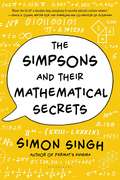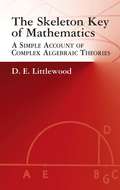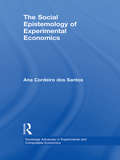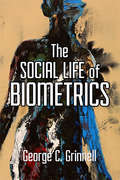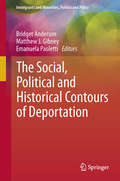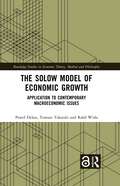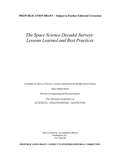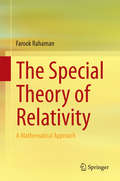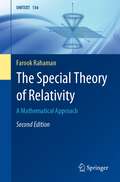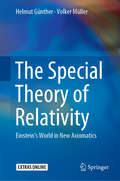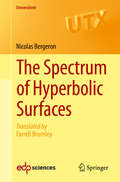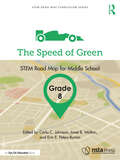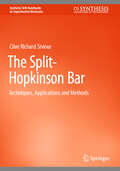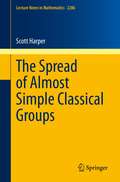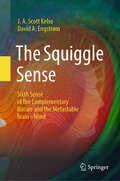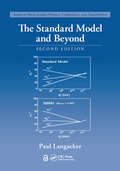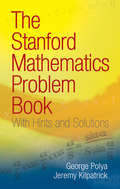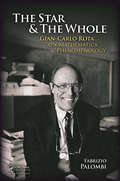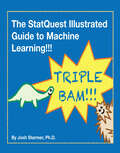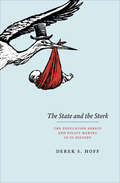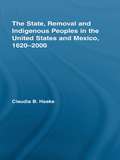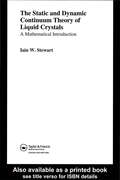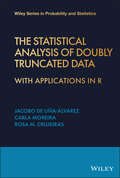- Table View
- List View
The Simpsons And Their Mathematical Secrets
by Simon SinghThe brainy book by the bestselling author of Fermat's Enigma - a must for anyone interested in numbers and mathematics, as well as for the millions of Simpsons fans worldwide.
The Skeleton Key of Mathematics: A Simple Account of Complex Algebraic Theories
by D. E. LittlewoodAs the title promises, this helpful volume offers easy access to the abstract principles common to science and mathematics. It eschews technical terms and omits troublesome details in favor of straightforward explanations that will allow scientists to read papers in branches of science other than their own, mathematicians to appreciate papers on topics on which they have no specialized knowledge, and other readers to cultivate an improved understanding of subjects employing mathematical principles. The broad scope of topics encompasses Euclid's algorithm; congruences; polynomials; complex numbers and algebraic fields; algebraic integers, ideals, and p-adic numbers; groups; the Galois theory of equations; algebraic geometry; matrices and determinants; invariants and tensors; algebras; group algebras; and more."It is refreshing to find a book which deals briefly but competently with a variety of concatenated algebraic topics, that is not written for the specialist," enthused the Journal of the Institute of Actuaries Students' Society about this volume, adding "Littlewood's book can be unreservedly recommended."
The Skew-Normal and Related Families
by Adelchi AzzaliniInterest in the skew-normal and related families of distributions has grown enormously over recent years, as theory has advanced, challenges of data have grown, and computational tools have made substantial progress. This comprehensive treatment, blending theory and practice, will be the standard resource for statisticians and applied researchers. Assuming only basic knowledge of (non-measure-theoretic) probability and statistical inference, the book is accessible to the wide range of researchers who use statistical modelling techniques. Guiding readers through the main concepts and results, it covers both the probability and the statistics sides of the subject, in the univariate and multivariate settings. The theoretical development is complemented by numerous illustrations and applications to a range of fields including quantitative finance, medical statistics, environmental risk studies, and industrial and business efficiency. The author's freely available R package sn, available from CRAN, equips readers to put the methods into action with their own data.
The Social Epistemology of Experimental Economics (Routledge Advances In Experimental And Computable Economics Ser.)
by Ana Cordeiro dos SantosAny experimental field consists of preparing special conditions for examining interesting objects for research. So naturally, the particular ways in which scientists prepare their objects determine the kind and the content of knowledge produced. This book provides a framework for the analysis of experimental practices - the Social Epistemology of Experiment - that incorporates both the ‘material’ and the ‘social’ dimensions of knowledge production. The Social Epistemology of Experiment is applied to experimental economics and in so doing, it introduces the epistemic role of the participation of human subjects in experiments and the causal efficacy of institutions in constraining and enabling human behaviour. It also develops the role of the social and socially established practices in overcoming the methodological difficulties associated with experimenting with humans subjects in the social sciences as well as the effect of scientists’ interventions in the laboratory worlds. This book provides an historical and contextualized account of the emergence of experimental economics, the methodological discussions that have informed and constituted it, its main research programmes, and stylized facts. The analysis of its three main research programmes – market experiments, game theory experiments and individual decision-making experiments – shows how economics experiments are particularly tailored to produce knowledge about market institutions and individual behaviour in contexts where there might be conflicts of individual and social goals, and also about the processes of individual decision-making.
The Social Life of Biometrics
by George C GrinnellIn The Social Life of Biometrics, biometrics is loosely defined as a discrete technology of identification that associates physical features with a legal identity. Author George Grinnell considers the social and cultural life of biometrics by examining what it is asked to do, imagined to do, and its intended and unintended effects. As a human-focused account of technology, the book contends that biometrics needs to be understood as a mode of thought that informs how we live and understand one another; it is not simply a neutral technology of identification. Placing our biometric present in historical and cultural perspective, The Social Life of Biometrics examines a range of human experiences of biometrics. It features individual stories from locations as diverse as Turkey, Canada, Qatar, Six Nations territory in New York State, Iraq, the skies above New York City, a university campus and Nairobi to give cultural accounts of identification and look at the ongoing legacies of our biometric ambitions. It ends by considering the ethics surrounding biometrics and human identity, migration, movement, strangers, borders, and the nature of the body and its coherence. How has biometric thought structured ideas about borders, race, covered faces, migration, territory, citizenship, and international responsibility? What might happen if identity was less defined by the question of “who’s there?” and much more by the question “how do you live?”
The Social, Political and Historical Contours of Deportation
by Matthew J. Gibney Emanuela Paoletti Bridget AndersonIn recent years states across the world have boosted their legal and institutional capacity to deport noncitizens residing on their territory, including failed asylum seekers, "illegal" migrants, and convicted criminals. Scholars have analyzed this development primarily through the lens of immigration control. Deportation has been viewed as one amongst a range of measures designed to control entrance, distinguished primarily by the fact that it is exercised inside the territory of the state. But deportation also has broader social and political effects. It provides a powerful way through which the state reminds noncitizens that their presence in the polity is contingent upon acceptable behavior. Furthermore, in liberal democratic states immunity from deportation is one of the key privileges that citizens enjoy that distinguishes them from permanent residents. This book examines the historical, institutional and social dimensions of the relationship between deportation and citizenship in liberal democracies. Contributions also include analysis of the formal and informal functions of administrative immigration detention, and the role of the European Parliament in the area of irregular immigration and borders. The book also develops an analytical framework that identifies and critically appraises grassroots and sub national responses to migration policy in liberal democratic societies, and considers how groups form after deportation and the employment of citizenship in this particular context, making it of interest to scholars and international policy makers alike. "It is commonly surmised that the increased flows of goods, ideas, finance and people are slowly leading to the dissolution of boundaries between nation-states. However, as the varied and excellent chapters in this collection demonstrate, the enforcement of state power through detention and deportation is still a real and growing feature of contemporary political life. Expulsion has always been a moral sanction (think of Adam and Eve being banished from the Garden of Eden or the ostracism directed against dissidents in ancient Athens, who were forced to leave for ten years). As the editors suggest, deportation remains a means of enforcing a normative order ('a community of values'), while the authors and editors of this book have expanded the subject-matter to include the deportees' perspectives and the effects of deportation on families, other potential victims and on those whose social inclusion has been affirmed by the exclusion of others. These studies will enrich and enlarge the study of the more naked forms of state power." - Robin Cohen, Professor Emeritus of Development Studies, University of Oxford "This wide-ranging, well-researched, and highly informative work is a major contribution to the growing body of scholarship examining the harsh consequences of deportation around the world. The editors have gathered an impressive group of scholars who craft an eclectic view of how deportation has evolved, what it may signify, and how it now works in various settings. With its inclusion of historical, institutional, comparative, and finely-textured, sensitive experiential studies, this book offers an important--if frequently distressing--overview of phenomena that deserve our full attention." - Daniel Kanstroom, Professor of Law and Director, International Human Rights Program, Boston College Law School
The Solow Model of Economic Growth: Application to Contemporary Macroeconomic Issues (Routledge Studies in Economic Theory, Method and Philosophy)
by Rafał Wisła Paweł Dykas Tomasz TokarskiIn 1956, Solow proposed a neoclassical growth model in opposition or as an alternative to Keynesian growth models. The Solow model of economic growth provided foundations for models embedded in the new theory of economic growth, known as the theory of endogenous growth, such as the renowned growth models developed by Paul M. Romer and Robert E. Lucas in the 1980s and 90s. The augmentations of the Solow model described in this book, excepting the Phelps golden rules of capital accumulation and the Mankiw-Romer-Weil and Nonneman-Vanhoudt models, were developed by the authors over the last two decades. The book identifies six spheres of interest in modern macroeconomic theory: the impact of fiscal and monetary policy on growth; the effect of different returns to scale on production; the influence of mobility of factors of production among different countries on their development; the effect of population dynamics on growth; the periodicity of investment rates and their influence on growth; and the effect of exogenous shocks in the form of an epidemic. For each of these issues, the authors construct and analyze an appropriate growth model that focuses on the description of the specific macroeconomic problem. This book not only continues the neoclassical tradition of thought in economics focused on quantitative economic change but also, and to a significant extent, discusses alternative approaches to certain questions of economic growth, utilizing conclusions that can be drawn from the Solow model. It is a useful tool in analyzing contemporary issues related to growth.
The South Texas Health Status Review: A Health Disparities Roadmap
by Ian M. Thompson Amelie G. Ramirez Leonel VelaThis book is a roadmap of the exact health disparities that burden the health of South Texas residents, especially Hispanics, compared to the rest of Texas and nation. This type of knowledge has the potential to fuel and motivate researchers and public health leaders to create and shape interventions to reverse those health disparities. Most notably, focus on obesity and diabetes prevention efforts and modifiable risk factors--such as nutrition, reproductive factors and access to health care--has significant potential to reduce the burden of disease in South Texas communities.South Texas, a 38-county region that spans 45,000 square miles along the Texas-Mexico border northward to the area around metropolitan Bexar County (home to San Antonio), is home to 18% of the state's population. Yet South Texas residents, who are 68% Hispanic, struggle with lower educational levels, less income and less access to health care--and, as a result, suffer from a wide variety of health disparities. To study the health status and identify the exact health disparities that exist in the region, researchers from The UT Health Science Center at San Antonio teamed with researchers from the Texas Department of State Health Services to develop the South Texas Health Status Review.The Review team analyzed a variety of the latest county, state and national data to compare South Texas' incidence, prevalence and mortality rates for more than 35 health indicators--from cancers to chronic diseases like diabetes to communicable diseases like HIV/AIDS to maternal health and even environmental health--to the rest of Texas and the nation by age, sex, race/ethnicity and rural/urban location.
The Space Science Decadal Surveys: Lessons Learned and Best Practices
by Committee on Survey of Surveys: Lessons Learned from the Decadal Survey ProcessThe National Research Council has conducted 11 decadal surveys in the Earth and space sciences since 1964 and released the latest four surveys in the past 8 years. The decadal surveys are notable in their ability to sample thoroughly the research interest, aspirations, and needs of a scientific community. Through a rigorous process, a primary survey committee and thematic panels of community members construct a prioritized program of science goals and objectives and define an executable strategy for achieving them. These reports play a critical role in defining the nation's agenda in that science area for the following 10 years, and often beyond. "The Space Science Decadal Surveys" considers the lessons learned from previous surveys and presents options for possible changes and improvements to the process, including the statement of task, advanced preparation, organization, and execution. This report discusses valuable aspects of decadal surveys that could taken further, as well as some challenges future surveys are likely to face in searching for the richest areas of scientific endeavor, seeking community consensus of where to go next, and planning how to get there. "The Space Science Decadal Surveys" describes aspects in the decadal survey prioritization process, including balance in the science program and across the discipline; balance between the needs of current researchers and the development of the future workforce; and balance in mission scale - smaller, competed programs versus large strategic missions.
The Special Theory of Relativity
by Farook RahamanThe book expounds the major topics in the special theory of relativity. It provides a detailed examination of the mathematical foundation of the special theory of relativity, relativistic mass, relativistic mechanics and relativistic electrodynamics. As well as covariant formulation of relativistic mechanics and electrodynamics, the book discusses the relativistic effect on photons. Using a mathematical approach, the text offers graduate students a clear, concise view of the special theory of relativity. Organized into 14 chapters and two appendices, the content is presented in a logical order, and every topic has been dealt with in a simple and lucid manner. To aid understanding of the subject, the book provides numerous relevant worked examples in every chapter. The book's mathematical approach helps students in their independent study and motivates them to research the topic further.
The Special Theory of Relativity: A Mathematical Approach (UNITEXT #136)
by Farook RahamanThis textbook expounds the major topics in the special theory of relativity. It provides a detailed examination of the mathematical foundation of the special theory of relativity, relativistic mass, relativistic mechanics, and relativistic electrodynamics. As well as covariant formulation of relativistic mechanics and electrodynamics, the text discusses the relativistic effect on photons. A new chapter on electromagnetic waves as well as several new problems and examples have been included in the second edition of the book. Using the mathematical approach, the text offers graduate students a clear, concise view of the special theory of relativity. Organized into 15 chapters and two appendices, the content is presented in a logical order, and every topic has been dealt with in a simple and lucid manner. To aid understanding of the subject, the text provides numerous relevant worked-out examples in every chapter. The mathematical approach of the text helps students in their independent study and motivates them to research the topic further.
The Special Theory of Relativity: Einstein’s World in New Axiomatics
by Helmut Günther Volker MüllerThis book discusses in detail the special theory of relativity without including all the instruments of theoretical physics, enabling readers who are not budding theoretical physicists to develop competence in the field. An arbitrary but fixed inertial system is chosen, where the known velocity of light is measured. With respect to this system a moving clock loses time and a moving length contracts. The book then presents a definition of simultaneity for the other inertial frames without using the velocity of light. To do so it employs the known reciprocity principle, which in this context serves to provide a definition of simultaneity in the other inertial frames. As a consequence, the Lorentz transformation is deduced and the universal constancy of light is established. With the help of a lattice model of the special theory of relativity the book provides a deeper understanding of the relativistic effects. Further, it discusses the key STR experiments and formulates and solves 54 problems in detail.
The Spectrum of Hyperbolic Surfaces
by Nicolas BergeronThistext is an introduction to the spectral theory of the Laplacian oncompact or finite area hyperbolic surfaces. For some of thesesurfaces, called "arithmetic hyperbolic surfaces", theeigenfunctions are of arithmetic nature, and one may use analytictools as well as powerful methods in number theory to study them. Afteran introduction to the hyperbolic geometry of surfaces, with aspecial emphasis on those of arithmetic type, and then anintroduction to spectral analytic methods on the Laplace operator onthese surfaces, the author develops the analogy between geometry(closed geodesics) and arithmetic (prime numbers) in proving theSelberg trace formula. Along with important number theoreticapplications, the author exhibits applications of these tools to thespectral statistics of the Laplacian and the quantum uniqueergodicity property. The latter refers to the arithmetic quantumunique ergodicity theorem, recently proved by Elon Lindenstrauss. Thefruit of several graduate level courses at Orsay and Jussieu, The Spectrum of Hyperbolic Surfaces allows the reader to review an array of classical results andthen to be led towards very active areas in modern mathematics.
The Speed of Green, Grade 8: STEM Road Map for Middle School (STEM Road Map Curriculum Series)
by Carla C. Johnson Erin E. Peters-Burton Janet B. WaltonWhat if you could challenge your eighth graders to design a racing vehicle with minimum environmental impact, while exploring the role of renewable and non-renewable energy sources? With this volume in the STEM Road Map Curriculum Series, you can! The Speed of Green outlines a journey that will steer your students toward authentic problem solving while grounding them in integrated STEM disciplines. Like the other volumes in the series, this book is designed to meet the growing need to infuse real-world learning into K–12 classrooms. This interdisciplinary, eight-lesson module uses project- and problem-based learning to help students explore the potential role of renewable and non-renewable energy sources in transportation, with an emphasis on the auto industry. Using their understanding of the engineering design process (EDP), scientific concepts, and environmental conservation considerations, student teams will develop a plan for a competitive automobile racing team to fuel its vehicle with minimal environmental impact. To support this goal, students will do the following: · Identify finite energy resources and distinguish between these and renewable energy sources, and identify implications of the use of those fuel sources on the environment; · Conduct life cycle analyses (LCAs) of various fuel sources and apply the results to make decisions about the effects of various fuel sources; · Identify several ways that carbon-based fuels have impacted the U.S. economy and foreign relations; · Identify the effects of human activities on the biosphere with an emphasis on the effects of the widespread use of carbon-based fuels; · Apply the engineering design process (EDP) to solve a problem, and design and build a small-scale electric vehicle; · Synthesize their learning and working collaboratively by creating and presenting a plan for a race team that minimizes its environmental impact; · Create an engaging presentation incorporating oral presentations and visual displays to present projects to an audience of peers, teachers, and industry professionals. The STEM Road Map Curriculum Series is anchored in the Next Generation Science Standards, the Common Core State Standards, and the Framework for 21st Century Learning. In-depth and flexible, The Speed of Green can be used as a whole unit or in part to meet the needs of districts, schools, and teachers who are charting a course toward an integrated STEM approach.
The Split-Hopkinson Bar: Techniques, Applications and Methods (Synthesis SEM Handbooks on Experimental Mechanics)
by Clive Richard SiviourThis book provides a concise practical introduction to the split-Hopkinson bar, by giving an overview of both the basic technique and a wide range of topics relevant to its application. The split-Hopkinson pressure bar (SHPB) has become the key apparatus for the characterization of the mechanical response of materials at high strain rates. Systems have been used at rates from approximately 100 to 1,000,000 s-1, to test materials ranging from low modulus elastomers to high strength superalloys. The power of the system is its suitability, with appropriate practice, to be used on many materials and in conjunction with a wide range of different diagnostic systems. Each chapter provides information and guidance for practitioners to perform high-quality experiments, whilst also introducing the resources required to engage in a deeper exploration of the topic.
The Spread of Almost Simple Classical Groups (Lecture Notes in Mathematics #2286)
by Scott HarperThis monograph studies generating sets of almost simple classical groups, by bounding the spread of these groups. Guralnick and Kantor resolved a 1962 question of Steinberg by proving that in a finite simple group, every nontrivial element belongs to a generating pair. Groups with this property are said to be 3/2-generated. Breuer, Guralnick and Kantor conjectured that a finite group is 3/2-generated if and only if every proper quotient is cyclic. We prove a strong version of this conjecture for almost simple classical groups, by bounding the spread of these groups. This involves analysing the automorphisms, fixed point ratios and subgroup structure of almost simple classical groups, so the first half of this monograph is dedicated to these general topics. In particular, we give a general exposition of Shintani descent. This monograph will interest researchers in group generation, but the opening chapters also serve as a general introduction to the almost simple classical groups.
The Squiggle Sense: Sixth Sense of the Complementary Nature and the Metastable Brain~Mind
by David A. Engstrøm J. A. KelsoEither/or thinking is a major stumbling block to human development and understanding. In this book Kelso & Engstrøm offer a whole new way of looking at the world, awakening a “sixth sense” that people didn’t realize they had. It draws on the profound relationship between nature’s many complementary contraries and the paradigm shifting science of coordination called Coordination Dynamics. The human brain~mind, through the multi- and metastable modes of its coordination dynamics, gives rise to a sentient faculty called the squiggle sense. Nature's contraries are perceived not only as opposing polar states, but as coexisting complementary tendencies, symbolized by the squiggle (~). Use this book to nudge your brain~mind into its metastable mode again and again, to better perceive the complementary dances of contraries, and to transcend the detrimental narrow-mindedness of polarized, either/or thinking. As a "Metastabilian" you can wield your squiggle sense to enhance and advance your life!
The Standard Model and Beyond (Series in Particle Physics, Cosmology and Gravitation)
by Paul LangackerThis new edition of The Standard Model and Beyond presents an advanced introduction to the physics and formalism of the standard model and other non-abelian gauge theories. It provides a solid background for understanding supersymmetry, string theory, extra dimensions, dynamical symmetry breaking, and cosmology. In addition to updating all of the experimental and phenomenological results from the first edition, it contains a new chapter on collider physics; expanded discussions of Higgs, neutrino, and dark matter physics; and many new problems. The book first reviews calculational techniques in field theory and the status of quantum electrodynamics. It then focuses on global and local symmetries and the construction of non-abelian gauge theories. The structure and tests of quantum chromodynamics, collider physics, the electroweak interactions and theory, and the physics of neutrino mass and mixing are thoroughly explored. The final chapter discusses the motivations for extending the standard model and examines supersymmetry, extended gauge groups, and grand unification. Thoroughly covering gauge field theories, symmetries, and topics beyond the standard model, this text equips readers with the tools to understand the structure and phenomenological consequences of the standard model, to construct extensions, and to perform calculations at tree level. It establishes the necessary background for readers to carry out more advanced research in particle physics. Supplementary materials are provided on the author’s website and a solutions manual is available for qualifying instructors.
The Stanford Mathematics Problem Book: With Hints and Solutions (Dover Books on Mathematics)
by G. Polya J. KilpatrickThis volume features a complete set of problems, hints, and solutions based on Stanford University's well-known competitive examination in mathematics. It offers high school and college students an excellent mathematics workbook of rigorous problems that will assist in developing and cultivating their logic and probability skills.These 20 sets of intriguing problems test originality and insight rather than routine competence. They involve theorizing and verifying mathematical facts; examining the results of general statements; discovering that highly plausible conjectures can be incorrect; solving sequences of subproblems to reveal theory construction; and recognizing "red herrings," in which obvious relationships among the data prove irrelevant to solutions. Hints for each problem appear in a separate section, and a final section features solutions that outline the appropriate procedures.Ideal for teachers seeking challenging practice math problems for their gifted students, this book will also help students prepare for mathematics, science, and engineering programs. Mathematics buffs of all ages will also find it a source of captivating challenges.
The Star and the Whole: Gian-Carlo Rota on Mathematics and Phenomenology
by Fabrizio PalombiThe Star and the Whole: Gian-Carlo Rota on Mathematics and Phenomenology, authored by Fabrizio Palombi, is the first book to study Rota's philosophical reflection. Rota (1932-1999) was a leading figure in contemporary mathematics and an outstanding philosopher, inspired by phenomenology, who made fundamental contributions to combinatorial analysis,
The StatQuest Illustrated Guide to Machine Learning!!!: Master the concepts, one full-color picture at a time, from the basics all the way to neural networks. BAM!
by Josh Starmer PhDWith over 300 pages of easy to follow, step-by-step illustrations, everyone can understand Machine Learning from the basics to advanced topics like neural networksKey FeaturesFully illustrated in color and written in the style of a graphic novel. BAM!Every concept is taught with a very gentle learning curve. DOUBLE BAM!!Every page is labeled as Main Ideas or Details, and you can focus on one, or the other, or both. TRIPLE BAM!!!Book DescriptionMachine Learning is awesome and powerful, but it can also appear incredibly complicated. That's where The StatQuest Illustrated Guide to Machine Learning comes in. This book takes the machine learning algorithms, no matter how complicated, and breaks them down into small, bite-sized pieces that are easy to understand. Each concept is clearly illustrated to provide you, the reader, with an intuition about how the methods work that goes beyond the equations alone. The StatQuest Illustrated Guide does not dumb down the concepts. Instead, it builds you up so that you are smarter and have a deeper understanding of Machine Learning.The StatQuest Illustrated Guide to Machine Learning starts with the basics, showing you what machine learning is and what are its goals, and builds on those, one picture at a time, until you have mastered the concepts behind self driving cars and facial recognition.What you will learnMaster the fundamentals to use, optimize and evaluate machine learningDevelop an intuition for fundamental statistics conceptsApply Statistical distributions, R-squared, p-values to your ML modelsGain deep insight into the building blocks like Gradient DescentVisualize machine learning methods, including Neural NetworksLearn about the limitations of machine learningWho this book is forThe StatQuest Illustrated Guide To Machine Learning is a great starting point for anyone who wants to get into the field of Machine Learning. It also serves as the perfect reference for seasoned practitioners who need to review key concepts for an upcoming job interview.For beginners, the illustrations and step-by-step approach ensure that the learning curve is as gentle as possible.For experts, the depth each topic is explored and the visualizations ensure “I finally understand!” moments occur in each chapter.
The State and the Stork: The Population Debate and Policy Making in US History
by Derek S. Hoff&“A powerful model of how to understand the complex array of issues that will shape the political economy of population in the future.&”—American Historical Review From the founders&’ fears that crowded cities would produce corruption, luxury, and vice to the zero population growth movement of the late 1960s to today&’s widespread fears of an aging crisis as the Baby Boomers retire, the American population debate has always concerned much more than racial composition or resource exhaustion, the aspects of the debate usually emphasized by historians. In The State and the Stork, Derek Hoff draws on his extraordinary knowledge of the intersections between population and economic debates throughout American history to explain the many surprising ways that population anxieties have provoked unexpected policies and political developments—including the recent conservative revival. At once a fascinating history and a revelatory look at the deep origins of a crucial national conversation, The State and the Stork could not be timelier. &“Hoff has done a real service by bringing to the foreground the economic dimension of U.S. debates over population size and growth, a topic that has been relegated to the shadows for too long.&”—Population and Development Review &“After decades of failed efforts by the scientific community to alert the public to the environmental dangers of population growth and overpopulation, a first-rate historian has finally detailed both the arguments and their policy implications . . . Everyone interested in population should read The State and the Stork. This is an incredibly timely book.&”—Paul R. Ehrlich, author of The Population Bomb
The State, Removal and Indigenous Peoples in the United States and Mexico, 1620-2000 (Indigenous Peoples and Politics)
by Claudia HaakeThis book investigates the forced migration of the Delawares in the United States and the Yaquis in Mexico, focusing primarily on the impact removal from tribal lands had on the (ethnic) identity of these two indigenous societies. It analyzes Native responses to colonial and state policies to determine the practical options that each group had in dealing with the states in which they lived. Haake convincingly argues that both nation-states aimed at the destruction of the Native American societies within their borders. This exemplary comparative, transnational study clearly demonstrates that the legacy of these attitudes and policies are readily apparent in both countries today. This book should appeal to a wide variety of academic disciplines in which diversity and minority political representation assume significance.
The Static and Dynamic Continuum Theory of Liquid Crystals: A Mathematical Introduction (Liquid Crystals Book Series)
by Iain W. StewartGiven the widespread interest in macroscopic phenomena in liquid crystals, stemming from their applications in displays and devices. The need has arisen for a rigorous yet accessible text suitable for graduate students, whatever their scientific background. This book satisfies that need.The approach taken in this text, is to introduce the basic continuum theory for nematic liquid crystals in equilibria, then it proceeds to simple application of this theory- in particular, there is a discussion of electrical and magnetic field effects which give rise to Freedericksz transitions, which are important in devices. This is followed by an account of dynamic theory and elementary viscometry of nemantics Discussions of backflow and flow-induced instabilities are also included. Smetic theory is also briefly introduced and summarised with some examples of equilibrium solutions as well as those with dynamic effects. A number of mathematical techniques, such as Cartesian tensors and some variational calculus, are presented in the appendices.
The Statistical Analysis of Doubly Truncated Data: With Applications in R (Wiley Series in Probability and Statistics)
by Rosa M. Crujeiras Jacobo de Uña-Álvarez Prof Carla MoreiraA thorough treatment of the statistical methods used to analyze doubly truncated data In The Statistical Analysis of Doubly Truncated Data, an expert team of statisticians delivers an up-to-date review of existing methods used to deal with randomly truncated data, with a focus on the challenging problem of random double truncation. The authors comprehensively introduce doubly truncated data before moving on to discussions of the latest developments in the field. The book offers readers examples with R code along with real data from astronomy, engineering, and the biomedical sciences to illustrate and highlight the methods described within. Linear regression models for doubly truncated responses are provided and the influence of the bandwidth in the performance of kernel-type estimators, as well as guidelines for the selection of the smoothing parameter, are explored. Fully nonparametric and semiparametric estimators are explored and illustrated with real data. R code for reproducing the data examples is also provided. The book also offers: A thorough introduction to the existing methods that deal with randomly truncated data Comprehensive explorations of linear regression models for doubly truncated responses Practical discussions of the influence of bandwidth in the performance of kernel-type estimators and guidelines for the selection of the smoothing parameter In-depth examinations of nonparametric and semiparametric estimators Perfect for statistical professionals with some background in mathematical statistics, biostatisticians, and mathematicians with an interest in survival analysis and epidemiology, The Statistical Analysis of Doubly Truncated Data is also an invaluable addition to the libraries of biomedical scientists and practitioners, as well as postgraduate students studying survival analysis.
